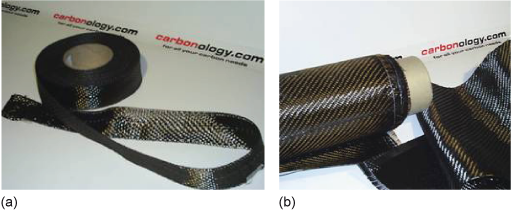3.2 Carbon fibre and composite materials
The term 'carbon fibre' is commonly used to refer to several materials that, although related, are not the same.
Strictly speaking, carbon fibres are the long, thread-like structures of linked carbon atoms that were discussed in Activity 4. When the fibres are woven into a cloth-like material (Figure 9), the resulting material is also referred to as carbon fibre.

However, the material most commonly associated with the term 'carbon fibre' is a plastic-like rigid material in which carbon-fibre cloth is used to reinforce a particular type of plastic. The technical term for this material is 'carbon-fibre-reinforced plastic', or CFRP. On its own, plastic has rigidity but lacks strength, but in CFRP the carbon-fibre cloth inside the plastic adds the necessary strength. This material is then used in sporting equipment such as bicycle frames, tennis racquets and hockey sticks. Carbon-fibre materials are so strong that they are even used to make many of the components in aircrafts, including parts of the wings.
Carbon-fibre reinforced plastic is an example of a class of substances called composite materials, in which two or more substances are combined to make a material with different properties from either of the individual components. Another example of a composite material is glass-fibre reinforced plastic, also known as fibreglass, in which thread-like structures of glass are used to reinforce plastic materials. Fibreglass has been used since the 1950s to make lightweight structures, ranging from household furniture to yachts and leisure craft. Both carbon fibre materials and fibreglass can be moulded into complex shapes, which is another reason why these materials are often preferred to the conventional, heavier alternatives of wood and steel.
